Lane Departure Prevention, Intelligent Cruise Control, and other advanced controls are Nissan’s newest line of features in some vehicles.
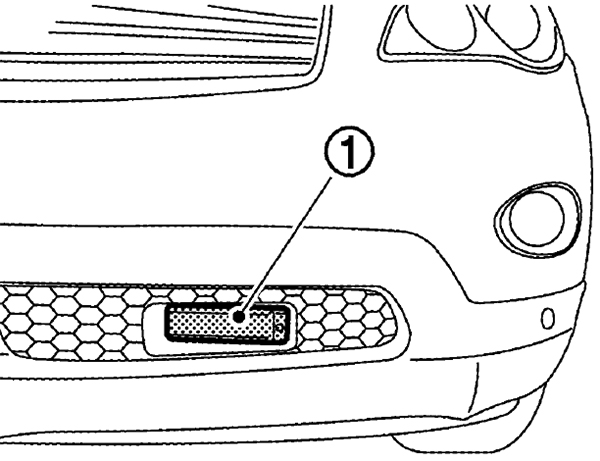
The main ICC sensor (1) also houses the computer used in determining how to control the rest of the vehicle based on sensor input.
Accidents happen. Sometimes nothing can be done to avoid a collision, but Nissan goes the extra mile with some of its newest vehicles to help reduce the likelihood of an accident occurring. We’ll take a look at how radar, sonar, camera, and laser inputs are used to monitor the area around the vehicle. This information, when combined with on-board VDC (Vehicle Dynamic Control) and all-wheel ABS, creates a car that can alert the driver about potential hazards. In some cases, the car can help reduce the severity of an accident by predicting an imminent collision. Taken together, these are often referred to as “Nissan Safety Shield Concept Technologies.”
High-tech help for the motorist
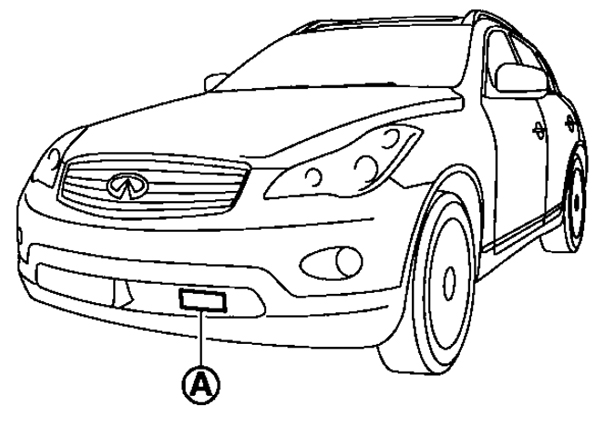
The ICC Reflector Detection Sensor (A) sweeps forward, identifying its surroundings based on other vehicles’ standard issue light reflectors.
It’s important to remain consistent with our terminology, so let’s spend a moment to talk about all the vehicle controls that comprise the Advanced Driver Assistance Systems ( ADAS). ADAS works with Vehicle Dynamic Control (VDC) to assist the driver by slowing the vehicle as necessary to maintain safe distance, or to use differential braking to create yaw adjustments, effectively steering the car. The core of ADAS is made up of sensors that are able to survey the road combined with VDC and ABS controls that allow the car to adapt to its surroundings.
In order to “see†forward-oriented objects, ADAS uses a forward-sweeping laser that can detect other vehicles, interpret their speed, and logically determine whether to apply the brakes and alert the driver. Two other assistance systems utilize this forward laser: Intelligent Cruise Control (ICC) and Distance Control Assistance (DCA). Both must be toggled and controlled by the driver using a switch. These systems utilize the forward ICC Sensor for decision making. In the case of ICC, the car will automatically adjust the vehicle’s speed and distance in relation to another vehicle in front in order to provide comfort when cruising, and to eliminate the need for constant adjustments by the driver. DCA works in a similar fashion, but if it is turned on, the vehicle will attempt to assist the driver at all times. This means that when DCA is engaged, the car will actively brake to a stop within the limitations of the system as necessary.
Lane Departure Prevention (LDP) uses a front camera mounted in the windshield to help keep the driver from wandering over the center lines, or onto the shoulder. This assistance feature must be toggled by the driver, and is temporarily disabled when using the turn signal.
Intelligent Brake Assist (IBA) helps the driver in the event of an emergency stop. IBA will remove the brake pedal free play, which shortens the effective reaction time of the driver. However, without any driver input, the vehicle won’t do anything on its own.
There are also many audio and visual warning systems that increase the driver’s awareness of his surroundings. When DCA detects another car ahead, the gauge cluster display will turn on the vehicle detected icon. If DCA cannot stop the vehicle in time, the Forward Collision Warning (FCW) will alert the driver with a chime that he must apply the brakes. Likewise, if another vehicle is located in a blind spot, the Blind Spot Warning (BSW) lights will be activated, and if the driver puts the turn signal on, a chime will sound. Of course, it’s up to the driver to properly signal for turns, and the system will not steer the car for him or her.
Many of these new features also help make ordinary tasks like parking or commuting safer. Multiple cameras make it easier to park or maneuver in tight spaces, and the ICC can allow a driver to retain safe distances while driving on straight highways. Let’s take a closer look at each subsystem.
The ICC Sensor makes DCA and Intelligent Cruise possible
There are multiple sensors, radar and sonar-emitting devices on the newest Nissan and Infiniti vehicles equipped with ADAS. Yet, the primary forward-looking sensor is a laser, and it lives below the bumper cover of vehicles so equipped. It also serves as the computer for making decisions about the vehicle’s position in time and space. These calculations are shared over CAN communications so ADAS can coordinate with DCA and ICC as necessary. Keep in mind that these advanced sensors are a trim-level option, and are not standard on every car.
Nissan calls the forward sensor cluster the ICC Sensor because it sweeps a laser beam outwards, and makes decisions based on the light that reflects back. The horizontal motion is calibrated internally, or at time of replacement, and if any upcoming threats are identified, the unit itself will communicate with the vehicle’s primary ECM and ABS control unit to act accordingly. In many models, all information about detected objects is calculated within the ICC sensor unit. These distance findings, when plotted over time, give the ICC ECU a sense of how fast the vehicle is moving toward identified objects.
When compared with inputs from the ABS ECU regarding vehicle speed, and from the ECM noting accelerator pedal position, the ADAS makes logical conclusions about whether the vehicle is at risk of collision with any of those perceived reflectors. It’s the same way a police officer’s laser gun determines speed.
An important note is that the forward ICC sensor is designed to ignore stationary reflectors, such as those found on guard rails or parked vehicles. Therefore, the driver is the most important safety feature on any vehicle, because only he or she can determine whether there is a stationary object on the road ahead, or if the road curves abruptly.
The ICC sensor is able to look just under 400 feet ahead. This long detection range makes DCA and Intelligent Cruise Control possible. Both features allow for the driver to set a desired following distance, and the ADAS can monitor and control the vehicle speed as necessary to maintain that distance. That is, with a little help from its friends, the ECM and the ABS control module. DCA logic works simply when its vehicle approaches another car:
- If the driver DOES NOT have his or her foot on the accelerator pedal (information provided from the ECM), up to 25% of the vehicle’s total braking power will be commanded (carried out by the ABS control unit) to slow the car down.
- On some models, if the driver DOES have his or her foot on the accelerator, the pedal assembly’s actuator will push against the driver’s foot in an effort to aid his or her letting off the accelerator.
If the driver forces the accelerator down despite the upward nudging mentioned above, Intelligent Cruise or DCA will be overridden. For as long as the driver is accelerating, the DCA or intelligent cruise will NOT apply braking even though it may “think” that is better. The driver may notice that the brake pedal goes down of its own accord during DCA or intelligent cruise. This is normal operation.
When driver braking input is required to stop, the FCW will sound a chime and blink the vehicle-ahead indicator on the gauge cluster display. If the driver goes against the DCA’s attempts, the system will cancel and NOT fight the driver.
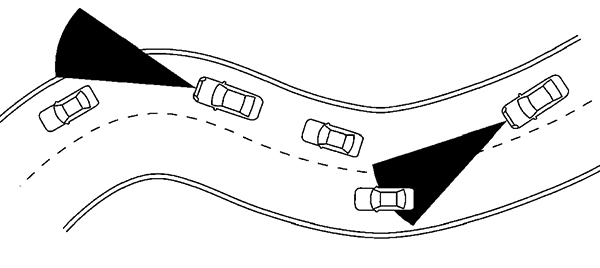
The sweep cone of the ICC Reflector Detection Sensor can be tricked by twisting roads. Safety systems are only a backup for the driver, who is responsible for paying attention at all times.
Vehicular Peripheral Vision
Human drivers don’t just stare straight ahead without regard for what’s around them. We must constantly monitor our surroundings to make safe lane changes, or react to possible threats. Some newer Nissan vehicles’ advanced assistance features also include side radar devices to detect other cars in your blind spots and report on the danger using Blind Spot Warning (BSW) indicators. The BSW system has its limitations, however. For example, like the forward ICC sensor, side radar cannot detect stationary objects. Also, it may not observe another vehicle merging at a far lane into the blind spot during a lane change. Lastly, the BSW will not “check†for a vehicle unless you use your turn signals. The turn signal switch is the first step in activating BSW, and only good driving habits will ensure the driver is signaling. Most importantly, BSW does not take the place of checking with your own eyes.
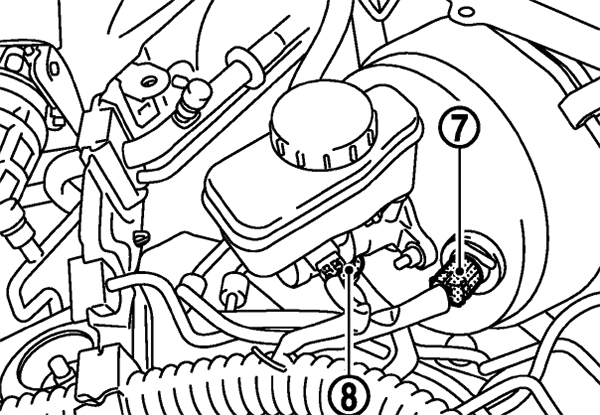
The boost solenoid (7) is responsible for firming up the pedal in event of emergency. The brake pressure sensor (8) is used in calculations for ABS/VSC behavior.
Bumper stickers may obscure the sensors and prevent proper operation. If one of your customer’s vehicles has body damage or bumper stickers on the rear corner areas, the BSW system may not work properly. Some calibration work is necessary after replacing sensors, and we will cover this later.
The “Voice” of an Intelligent Car
When the forward ICC sensor cluster determines that driver input is necessary to prevent a problem, there will be a warning chime and a gauge cluster indicator. This is also considered the Forward Collision Warning (FCW).
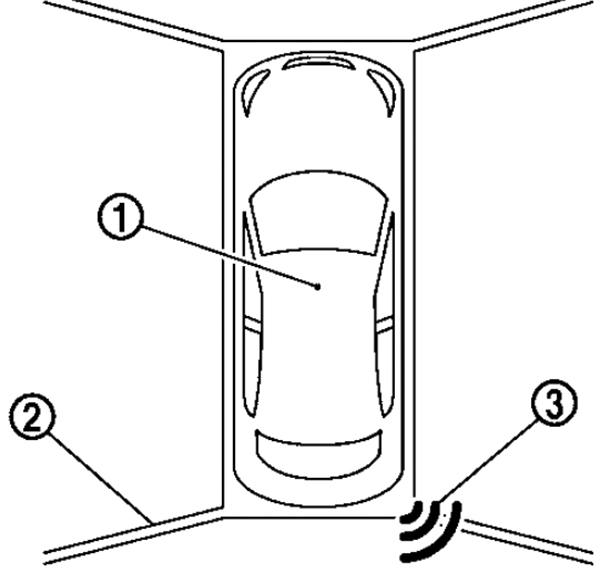
The bird’s eye view camera shows the car (1), the wide angle rear camera view (2), and a sonar proximity warning indicator (3).
When a customer signals for a turn, the ADAS will check the right- or left-hand radar sensor about whether the blind spots are clear. If an object is detected, the blind spot indicator (BSI) located on the door mirror corner cover will illuminate orange to alert the driver that something is there. Likewise, the dash indicator will illuminate. If the turn is continued, a warning chime will sound and the BSW dash indicator will blink. At that point, the driver may or may not stop the collision course, but the car has done all in its power to reduce the chances of mishap.
NOTE: Radar may not accurately detect small objects like bicycles or motorcycles.
Intelligent Brake Assist takes up the slack
Nissan has designed its new assistance systems well enough that a car equipped with ADAS features will often “know†that it will be in an accident before the driver does. The “preview function†will activate when the ADAS has determined that a forward collision is inevitable. In times of these detected emergencies, the ADAS communicates with the ABS control unit to provide a small amount of pressure to the booster, which eliminates the free play in the brake pedal. This happens before the driver even knows there’s an emergency, and once he or she does, the brake pedal will be firm and immediately begin working.
If there is no emergency, after one full second, the pre-loaded brake pedal will return to normal. Likewise, if the driver pushes the brake or accelerator pedals, IBA will cease.
Vehicle Dynamic Control and ABS
While the ICC systems are indispensable for figuring out what to avoid, Vehicle Dynamic Control (VDC) is responsible for ultimately making it all happen. VDC works in conjunction with ABS, interpreting signals from the ADAS computer and the primary ECU. VDC will control brake pressure to reduce wheel slip, so power is transferred to a non-slipping axle. It also controls engine output directly via the ECU and fuel injection cut off. It monitors brake pressure and accelerator pedal pressure to determine the reaction and intention of the driver. VDC is also the primary factor in making Lane Drift Prevention (LDP) possible.
The LDP uses a camera positioned near the rear-view mirror to interpret lane markings. If a road does not use lane markings, or the ones visible to the driver are worn, LDP will not work properly. It will also not make lane corrections greater than 20 degrees, so don’t expect the car to steer for you. Also, LDP is only active at 45 mph or greater.
Lane Departure Correction begins when the ADAS notices that the driver steering input indicated by the steering angle sensor is not sufficient to continue the trajectory between the visible lane markings. Once this is detected, the system does NOT move the steering wheel. It begins to apply braking pressure by means of VDC to one side of the vehicle. In other words, if LDP wants to steer the vehicle slightly to the right, it will apply light brake pressure to the right front and right rear. VDC will receive the data from the ADAS, and then, in turn, command the ABS to apply brake pressure to the necessary wheels.
In the meantime, the LDP warning indicator will illuminate on the dash and a chime will attempt to wake up the driver, or otherwise alert him or her of the car’s corrective action. If the driver was attempting to change lanes as indicated by the turn signal, LDP will not fight with the driver and once he or she continues to steer consistently in a particular direction, LDP will automatically cancel. As expected, if the driver uses the turn signal, LDP will temporarily be disabled in the direction of the signal.

The special service tool reflection plate (1) must be placed about 13 feet (L1) from the ICC sensor (2). The center of the vehicle (3) will be about 10 inches (W) off-set from the reflection plate, which is set at a 25 degree angle (A).
Because LDP uses a forward-facing camera, driving directly into the sun can prevent normal operation. This is also true of the ICC sensor cluster’s laser. It can also fail due to low light or adverse weather conditions. Using common sense, it would probably be best to control your car yourself in those situations anyway.
Parking Assistance/Around View Monitor
Not only do modern Nissan and Infiniti vehicles enhance driving safely, they come equipped to handle the most common parking situations. Many low-speed accidents can occur, and multiple cameras can help drivers notice their surroundings better. There are usually three cameras and a set of sonar devices that will display the vehicle’s surroundings when reverse is engaged. On the primary Multi-Function Display (MFD), once the car is shifted into reverse, the driver will get a rear camera view with two perspective lines. The two lines represent the width of the vehicle, and the tick marks represent approximate distance. The standard reverse camera is common enough, but once the driver toggles a button on the MFD, he or she can gain access to a wide-angle rear-view camera, a passenger side view, a bird’s-eye view, and a front camera if necessary.
The side camera is located on the passenger-side mirror. The bird’s eye view is actually quite interesting because it generates a composite from the input of all the cameras to create a facsimile of where your vehicle is in space. The front camera gives the same ability as the rear camera to “get right up†to something, which is excellent for parallel parking.
Service and Diagnosis of ICC
Considering the newness of these technologies, there is no precedent for what may malfunction as a matter of course. All cars break, but some cars will be involved in a collision despite their modern features. Many auto body shops will likely have to replace the ICC sensor module in the front bumper. Such service should be performed by a facility competent in Nissan repair. First, the CONSULT III plus is required for the calibration of the sensor once it’s been installed. There is no way around this. Second, a special service tool (J-45718) is required to set up and calibrate the ICC laser.
We cannot stress enough that it is important to look up the specific step-by-step procedure for the vehicle concerned at www.nissan-techinfo.com. Just to give you a basic idea of what’s typically involved, however, we’ll say that once the tools are set up, you should ensure that there is nothing behind the reflection plate that may interfere with calibration. Begin work support functionality on the CONSULT III plus, choose LASER BEAM ADJUST and begin to calibrate the vertical orientation of the laser. This requires turning the adjusting screw on the ICC sensor assembly, and once it is within vertical spec, pushing END on the CONSULT III plus. It will take about 10 seconds for the CONSULT III plus to automatically configure the horizontal scan. Confirm the repair with a test drive using DCA.
An important diagnostic tool is also the memory stored of the last reason for cancellation of cruise control. Many of the first difficulties with the system will likely be customer complaints that ICC “stopped working†for some reason. Using the CONSULT III plus, choose work support and you can identify the last five CAUSE OF AUTO-CANCEL. For example, operating the windshield wipers on high will cancel the auto-follow feature of ICC, but it will not cancel conventional cruise control. This may confuse your customers, but from the car’s perspective, if you have to use your wipers, the reliance on a possibly obstructed laser may be a hazard. Likewise, when ABS is engaged, it cancels DCA as well as ICC, but not the conventional cruise control.
We’ll close with a few extra notes:
- ADAS functions vary greatly by model and year.
- The newest JX model will use radar for the ICC sensor.
- The JX also has new functions that we will cover in a future article.
- Newer models have customizable settings for enable/disable.

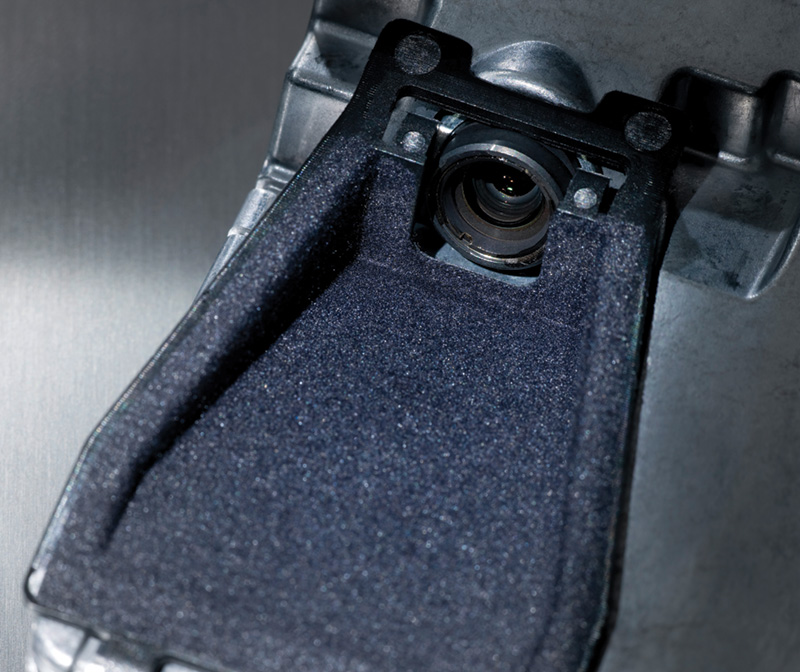
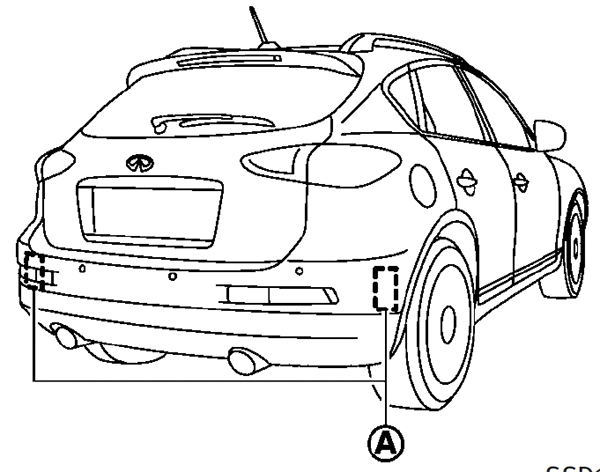




0 Comments